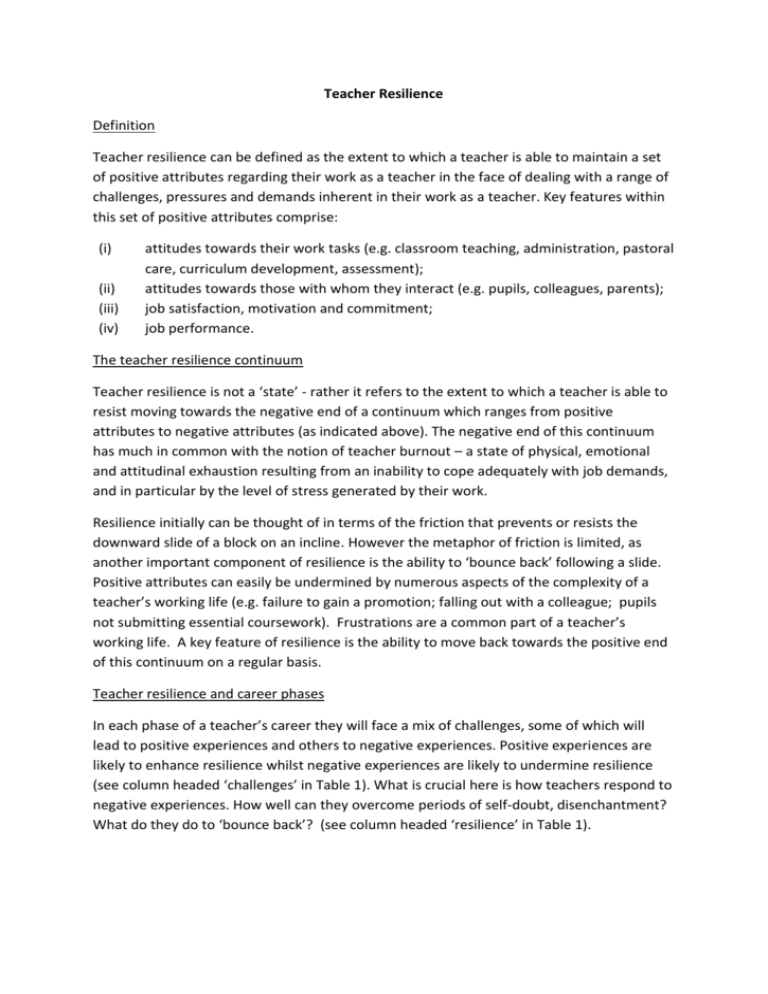Teacher Resilience Definition Teacher resilience can be defined as
advertisement

Teacher Resilience Definition Teacher resilience can be defined as the extent to which a teacher is able to maintain a set of positive attributes regarding their work as a teacher in the face of dealing with a range of challenges, pressures and demands inherent in their work as a teacher. Key features within this set of positive attributes comprise: (i) (ii) (iii) (iv) attitudes towards their work tasks (e.g. classroom teaching, administration, pastoral care, curriculum development, assessment); attitudes towards those with whom they interact (e.g. pupils, colleagues, parents); job satisfaction, motivation and commitment; job performance. The teacher resilience continuum Teacher resilience is not a ‘state’ - rather it refers to the extent to which a teacher is able to resist moving towards the negative end of a continuum which ranges from positive attributes to negative attributes (as indicated above). The negative end of this continuum has much in common with the notion of teacher burnout – a state of physical, emotional and attitudinal exhaustion resulting from an inability to cope adequately with job demands, and in particular by the level of stress generated by their work. Resilience initially can be thought of in terms of the friction that prevents or resists the downward slide of a block on an incline. However the metaphor of friction is limited, as another important component of resilience is the ability to ‘bounce back’ following a slide. Positive attributes can easily be undermined by numerous aspects of the complexity of a teacher’s working life (e.g. failure to gain a promotion; falling out with a colleague; pupils not submitting essential coursework). Frustrations are a common part of a teacher’s working life. A key feature of resilience is the ability to move back towards the positive end of this continuum on a regular basis. Teacher resilience and career phases In each phase of a teacher’s career they will face a mix of challenges, some of which will lead to positive experiences and others to negative experiences. Positive experiences are likely to enhance resilience whilst negative experiences are likely to undermine resilience (see column headed ‘challenges’ in Table 1). What is crucial here is how teachers respond to negative experiences. How well can they overcome periods of self-doubt, disenchantment? What do they do to ‘bounce back’? (see column headed ‘resilience’ in Table 1). Table 1: Teacher resilience across career phases Career Phase Early career Mid career Late career Challenges Positive Negative Experiences Experiences Workload Discipline Finance Renewal Promotion Responsibilities Change Routine Energy Managing others Accountability Obsolescence Enhancing resilience The factors that contribute to enhancing resilience include: (i) (ii) (iii) (iv) (v) (vi) (vii) Building up the skills needed to deal with demands Changing work practices Avoiding areas of vulnerability Taking advice Making use of social support Adopting positive mental strategies Having out-of-school interests Other factors (i) (ii) (iii) Personality (including self-efficacy beliefs) Consequences Options Dr Chris Kyriacou, University of York, 25th May 2010 Resilience Positive Negative Responses Responses Developing Competence Expertise and Rejuvenation Comfort and Challenge






